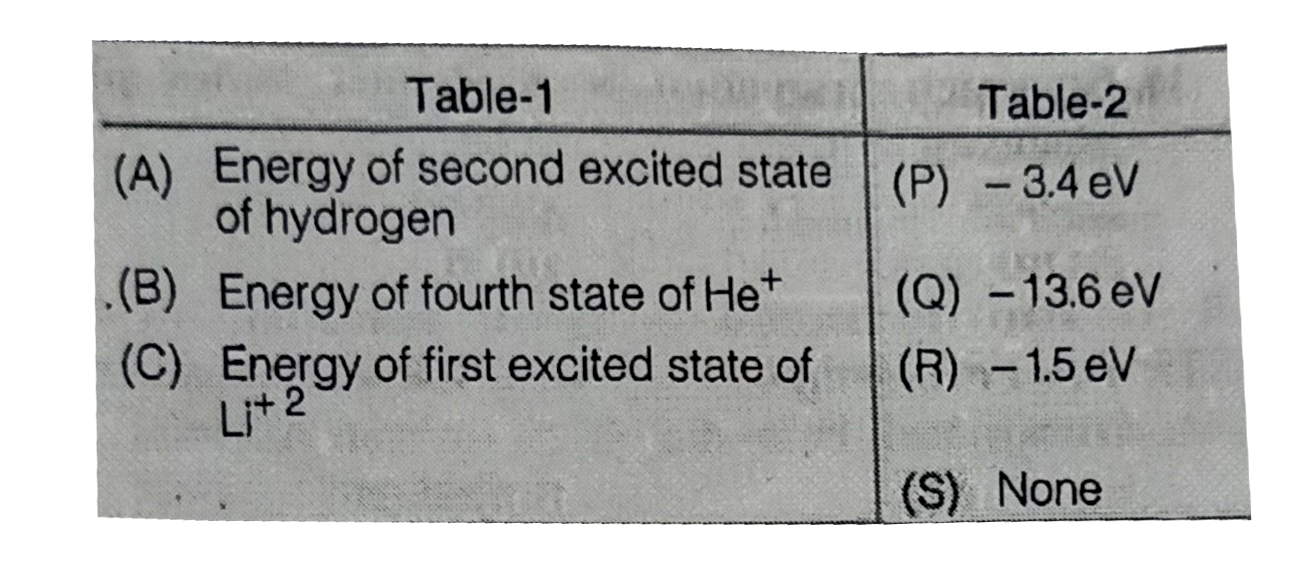Electrons of energy 12.1 eV are fired at hydrogen atoms in a discharge tube. If the ionization potential of hydrogen is 13.6 eV, then
Hydrogen atom may emit a wavelength 1028 Å
Hydrogen atom may emit a wavelength 6581 Å
Hydrogen atom may emit a wavelength 970 Å
Hydrogen atom may emit a wavelength 1217 Å
The correct Answer is:A, B, D
To solve the problem, we need to analyze the energy levels of the hydrogen atom and the energy of the electrons being fired at it. Here’s a step-by-step breakdown of the solution:
Step 1: Understand the Energy Levels of Hydrogen
The energy levels of the hydrogen atom can be calculated using the formula:
En=−13.6eVn2
where n is the principal quantum number.
- For n=1 (ground state):
E1=−13.612=−13.6eV
- For n=2:
E2=−13.622=−3.4eV
- For n=3:
E3=−13.632=−1.51eV
Step 2: Determine the Ionization Potential
The ionization potential of hydrogen is given as 13.6 eV. This means that to remove an electron from the ground state (n=1), an energy of 13.6 eV is required.
Step 3: Analyze the Energy of the Incoming Electrons
The energy of the incoming electrons is 12.1 eV. Since this energy is less than the ionization potential (13.6 eV), the electrons cannot ionize the hydrogen atoms. However, they can excite the electrons to higher energy levels.
Step 4: Determine Possible Excitation Levels
The electrons can be excited from the ground state (n=1) to higher levels. The maximum energy available for excitation is:
12.1eV−(−13.6eV)=12.1+13.6=25.7eV
The energy differences between the levels are:
- From n=1 to n=2:
E12=E2−E1=−3.4−(−13.6)=10.2eV
- From n=1 to n=3:
E13=E3−E1=−1.51−(−13.6)=12.09eV
Since 12.1 eV is just slightly less than 12.09 eV, the electrons can excite the hydrogen atom to the n=3 state.
Step 5: Calculate the Wavelengths of Emission
When the electron returns to a lower energy state, it emits a photon. We calculate the wavelengths for the transitions:
1. From n=3 to n=1:
E31=E3−E1=−1.51−(−13.6)=12.09eV
λ1=hcE31
λ1=(6.626×10−34J s)(3×108m/s)12.09×1.6×10−19J
λ1≈102.6nm
2. From n=3 to n=2:
E32=E2−E3=−3.4−(−1.51)=1.89eV
λ2=hcE32
λ2=(6.626×10−34J s)(3×108m/s)1.89×1.6×10−19J
λ2≈657.5nm
3. From n=2 to n=1:
E21=E2−E1=−3.4−(−13.6)=10.2eV
λ3=hcE21
λ3=(6.626×10−34J s)(3×108m/s)10.2×1.6×10−19J
λ3≈121.6nm
Conclusion
The wavelengths corresponding to the transitions are approximately:
- λ1≈102.6nm (from n=3 to n=1)
- λ2≈657.5nm (from n=3 to n=2)
- λ3≈121.6nm (from n=2 to n=1)
The energy levels of the hydrogen atom can be calculated using the formula:
En=−13.6eVn2
where n is the principal quantum number.
E1=−13.612=−13.6eV
- For n=2:
E2=−13.622=−3.4eV
- For n=3:
E3=−13.632=−1.51eV
The ionization potential of hydrogen is given as 13.6 eV. This means that to remove an electron from the ground state (n=1), an energy of 13.6 eV is required.
The energy of the incoming electrons is 12.1 eV. Since this energy is less than the ionization potential (13.6 eV), the electrons cannot ionize the hydrogen atoms. However, they can excite the electrons to higher energy levels.
The electrons can be excited from the ground state (n=1) to higher levels. The maximum energy available for excitation is:
12.1eV−(−13.6eV)=12.1+13.6=25.7eV
- From n=1 to n=2:
E12=E2−E1=−3.4−(−13.6)=10.2eV
- From n=1 to n=3:
E13=E3−E1=−1.51−(−13.6)=12.09eV
When the electron returns to a lower energy state, it emits a photon. We calculate the wavelengths for the transitions:
E31=E3−E1=−1.51−(−13.6)=12.09eV
λ1=hcE31
λ1=(6.626×10−34J s)(3×108m/s)12.09×1.6×10−19J
λ1≈102.6nm
E32=E2−E3=−3.4−(−1.51)=1.89eV
λ2=hcE32
λ2=(6.626×10−34J s)(3×108m/s)1.89×1.6×10−19J
λ2≈657.5nm
E21=E2−E1=−3.4−(−13.6)=10.2eV
λ3=hcE21
λ3=(6.626×10−34J s)(3×108m/s)10.2×1.6×10−19J
λ3≈121.6nm
The wavelengths corresponding to the transitions are approximately:
- λ1≈102.6nm (from n=3 to n=1)
- λ2≈657.5nm (from n=3 to n=2)
- λ3≈121.6nm (from n=2 to n=1)
Topper's Solved these Questions
- ATOMSBOOK - AAKASH INSTITUTE ENGLISHCHAPTER - ATOMSEXERCISE - ASSIGNMENT SECTION D (Linked Comprehension)
4 Videos
- ATOMSBOOK - AAKASH INSTITUTE ENGLISHCHAPTER - ATOMSEXERCISE - ASSIGNMENT SECTION E (Assertion-Reason)
2 Videos
- ATOMSBOOK - AAKASH INSTITUTE ENGLISHCHAPTER - ATOMSEXERCISE - ASSIGNMENT SECTION B Objective (One option is correct )
12 Videos
- ALTERNATING CURRENT BOOK - AAKASH INSTITUTE ENGLISHCHAPTER - ALTERNATING CURRENT EXERCISE - Assignment (Section-J) (Aakash Chailengers Questions)
2 Videos
- COMMUNICATION SYSTEMS BOOK - AAKASH INSTITUTE ENGLISHCHAPTER - COMMUNICATION SYSTEMS EXERCISE - ASSIGNMENT SECTION D (Assertion-Reason)
10 Videos
Similar Questions
Knowledge Check
If the ionisation potential for hydrogen atom is 13.6 eV, then the ionisation potential for He+ ion should be
A27.2 eVB54.4 eVC6.8 eVD13.6 eV.
The ionization energy of a hydrogen atom is εion=13.6eV. Yet the ionization of hydrogen atoms is observed at temperatures for which the average kinetic energy is much less. How can this fact be explained?
View SolutionTotal energy of the electron in hydrogen atom above 0 eV leads to
View SolutionThe energy of the electron in the ground state of hydrogen atom is −13.6eV. Find the kinetic energy and potential energy of electron in this state.
View SolutionThe energy of the electron in the ground state of hydrogen atom is −13.6eV. Find the kinetic energy and potential energy of electron in this state.
View SolutionThe energy of the electron in the ground state of hydrogen atom is −13.6eV. Find the kinetic energy and potential energy of electron in this state.
View SolutionTotal energy of an electron in the hydrogen atom in the ground state is -13.6 eV. The potential energy of this electron is
View SolutionTotal energy of an electron in the hydrogen atom in the ground state is -13.6 eV. The potential energy of this electron is
View Solution

